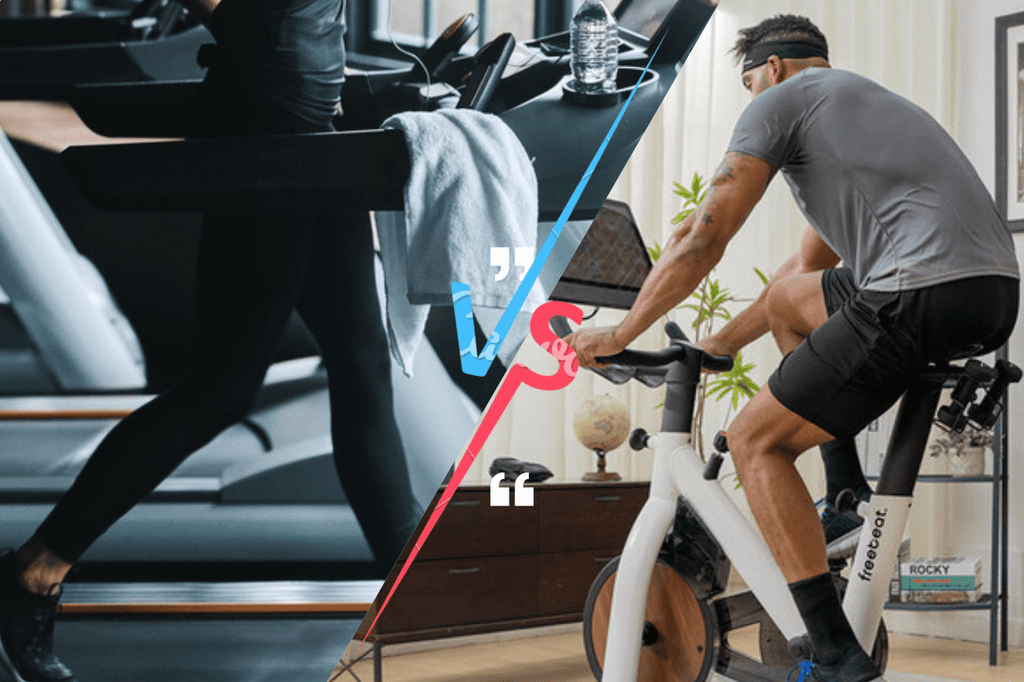Are you trying to decide between a spin bike and a treadmill for your home workout routine? You’re not alone.
Many fitness enthusiasts find themselves torn between these popular exercise machines. Each offers unique benefits, but which one is truly better for your fitness goals and lifestyle? In this blog post, we’ll dive into the key differences, advantages, and potential drawbacks of both the spin bike and the treadmill.
By the end, you’ll have a clearer picture of which equipment best suits your needs, helping you make an informed decision. Keep reading to discover how your choice could impact your health and fitness journey.
Cardio Benefits Compared
Choosing between a spin bike and a treadmill depends on your fitness goals. Both machines offer great cardio workouts.
This comparison looks at calorie burn, heart health, and endurance building to help you understand their benefits.
Calorie Burn Differences
Spin bikes and treadmills burn calories at different rates. The intensity of your workout plays a big role.
| Exercise | Calories Burned (30 mins) |
|---|---|
| Spin Bike (moderate effort) | 210-311 |
| Spin Bike (vigorous effort) | 315-466 |
| Treadmill (walking) | 150-220 |
| Treadmill (running) | 300-444 |
Impact On Heart Health
Both exercises improve heart health by raising your heart rate. Regular workouts strengthen your heart muscle.
- Spin bikes offer low-impact cardio, good for joint health.
- Treadmills provide weight-bearing exercise, which can improve bone strength.
- Both support better blood circulation and lower blood pressure.
Endurance Building
Endurance grows by gradually increasing workout time and intensity on either machine.
Spin bikes let you adjust resistance levels easily. Treadmills allow speed and incline changes.
Tips to boost endurance:
- Start with short sessions and add 5 minutes weekly.
- Alternate between moderate and high intensity.
- Focus on steady breathing and good posture.

Muscle Engagement
Both spin bikes and treadmills work muscles in different ways. Understanding muscle engagement helps you pick the right exercise.
Spin bikes focus on cycling muscles. Treadmills target running and walking muscles. Each machine affects your body uniquely.
Lower Body Focus
Spin bikes mainly work your legs, especially the thighs and calves. The pedaling action targets muscles like quads and hamstrings.
Treadmills engage leg muscles too, but they use different movements. Running or walking activates the glutes and calves more.
- Spin bike targets quads, hamstrings, calves
- Treadmill activates glutes, calves, and shins
- Spin bike uses circular pedaling motion
- Treadmill uses impact from foot strikes
Core Activation
Spin bikes require some core strength to keep balance and posture. You must hold your body steady during cycling.
Treadmills engage the core more actively to stabilize your body while running or walking. This helps keep your balance.
- Spin bike uses core for balance and posture
- Treadmill engages core to stabilize movement
- Running on treadmill requires more core control
Upper Body Involvement
Spin bikes mostly focus on the lower body. Your arms hold the handlebars but do not work hard.
Treadmills involve the arms more through natural swinging. This movement helps with balance and rhythm.
- Spin bike arms hold handlebars lightly
- Treadmill arms swing naturally while running
- Upper body work is mild on both machines
Joint Impact And Safety
Choosing the right exercise machine helps protect your joints. Spin bikes and treadmills affect your knees and ankles in different ways. Understanding their impact can help you stay safe and avoid injuries.
We will look at stress on joints, injury risks, and how each machine fits different fitness levels.
Stress On Knees And Ankles
Spin bikes cause less stress on knees and ankles than treadmills. The pedaling motion is low-impact and smooth. Treadmills involve repeated foot strikes that can strain joints.
- Spin bikes keep feet in place, reducing joint twisting.
- Treadmills can cause more impact from running or walking.
- Spin bikes allow controlled resistance to avoid overloading joints.
- Treadmill speed and incline may increase joint pressure.
Injury Risks
Both machines carry injury risks, but they differ in type and frequency. Spin bikes reduce impact injuries but can cause muscle strain if used incorrectly. Treadmills may lead to falls or joint pain.
| Risk Type | Spin Bike | Treadmill |
| Joint Pain | Low | Moderate to High |
| Muscle Strain | Moderate | Low |
| Falls | Rare | Possible |
| Overuse Injuries | Possible | Common |
Suitability For Different Fitness Levels
Each machine suits different users based on fitness and joint health. Spin bikes work well for beginners and people with joint issues. Treadmills can be good for those with stronger joints and higher fitness goals.
- Spin bikes offer adjustable resistance for all levels.
- Treadmills allow walking or running but need joint strength.
- Beginners may find spin bikes easier to control and safer.
- Advanced users might prefer treadmills for high-intensity workouts.

Workout Variety And Customization
Choosing between a spin bike and a treadmill depends on how much variety and customization you want in your workouts. Both machines offer ways to change your exercise routine, but they do it differently.
Understanding how each machine controls intensity, offers program options, and supports interval training can help you decide which fits your needs better.
Intensity Control
Spin bikes let you adjust resistance to make pedaling harder or easier. This gives you direct control over workout intensity.
Treadmills control intensity mostly by changing speed and incline. You can run faster or walk uphill to increase effort.
- Spin bike: resistance knob or digital setting
- Treadmill: speed and incline buttons
- Both allow gradual changes for steady progress
Program Options
Spin bikes often include preset programs that simulate hills or sprints. These help keep workouts interesting and varied.
Treadmills offer many built-in programs like fat burn, cardio, or heart rate control. This variety suits different fitness goals.
- Spin bike: hill climb, endurance, interval modes
- Treadmill: walking, running, interval, heart rate programs
- Programs help users stay motivated and consistent
Interval Training Potential
Spin bikes are great for interval training because you can quickly change resistance. This lets you alternate between hard and easy pedaling.
Treadmills also support intervals by switching speed and incline fast. Running sprints and recovery walks are easy to set up.
- Spin bike: fast resistance changes for intervals
- Treadmill: quick speed and incline adjustments
- Both machines boost cardio fitness with interval workouts
Space And Convenience
Choosing between a spin bike and a treadmill depends on your space and convenience needs. Both machines offer good workouts but differ in size, portability, and noise.
Understanding these factors helps you pick the right equipment for your home or gym.
Equipment Size
Spin bikes are usually smaller than treadmills. They take up less floor space and fit well in tight rooms. Treadmills need more length and width. This can limit where you place them.
| Equipment | Average Size (L × W × H) |
| Spin Bike | 40 × 20 × 45 inches |
| Treadmill | 70 × 30 × 55 inches |
Portability
Spin bikes are easier to move around. They often have wheels and weigh less. Treadmills are heavy and bulky. Moving them needs more effort.
- Spin bikes usually weigh 40 to 60 pounds
- Treadmills can weigh over 150 pounds
- Spin bikes have built-in wheels for easy rolling
- Treadmills may have wheels but still require two people to move safely
Noise Levels
Spin bikes create less noise. Their design keeps sounds low during pedaling. Treadmills tend to be louder. The motor and belt generate noise as you run or walk.
| Equipment | Noise Level (Decibels) |
|---|---|
| Spin Bike | 50 – 60 dB |
| Treadmill | 60 – 75 dB |
Cost And Maintenance
Choosing between a spin bike and a treadmill depends on many factors. Cost and maintenance are important to consider.
This section explores initial investment, upkeep needs, and the lifespan of each option.
Initial Investment
Spin bikes usually cost less than treadmills. You can find quality spin bikes at lower prices.
- Spin bikes range from $300 to $1,500
- Treadmills start around $600 and can go over $3,000
- Extra features raise the price of both machines
Upkeep Requirements
Spin bikes need less maintenance. They have fewer moving parts exposed to wear.
| Equipment | Typical Maintenance | Frequency |
| Spin Bike | Check belts and clean frame | Every 6 months |
| Treadmill | Lubricate belt and inspect motor | Every 3 to 6 months |
| Treadmill | Replace belt or motor parts | Every 1 to 3 years |
Longevity
Both machines can last many years with care. Treadmills may need parts replaced sooner.
Factors that affect lifespan:
- Usage frequency
- Quality of the machine
- Proper maintenance
User Experience And Motivation
Choosing between a spin bike and a treadmill depends on how you like to exercise. Both machines offer good workouts but feel different to use.
Your comfort and motivation will guide which machine fits your needs better.
Comfort And Ergonomics
Spin bikes let you sit while pedaling, which can reduce joint stress. You can adjust the seat and handlebars to fit your body.
Treadmills require standing and running or walking. They offer less adjustability but allow natural movement.
- Spin bike: adjustable seat and handlebars
- Spin bike: lower impact on knees and ankles
- Treadmill: natural running or walking motion
- Treadmill: less adjustability in posture
Engagement And Enjoyment
Spin bikes often include programs that simulate real rides. This can make workouts feel more exciting.
Treadmills allow you to change speed and incline easily. You can also watch videos or listen to music while running.
- Spin bikes: interactive riding programs
- Spin bikes: feel like cycling outdoors
- Treadmills: control speed and incline
- Treadmills: easy to multitask while exercising
Community And Classes
Spin bikes are popular in group classes. Riding with others can boost motivation and make workouts fun.
Treadmills are usually used alone but some gyms offer treadmill classes or challenges. These can also help keep you motivated.
- Spin bikes: group classes and team rides
- Spin bikes: social support in workouts
- Treadmills: solo exercise mostly
- Treadmills: occasional group challenges available

Frequently Asked Questions
Is A Spin Bike Better For Weight Loss Than A Treadmill?
A spin bike offers intense cardio and lower joint impact, boosting fat burn effectively. However, a treadmill burns more calories running. Choice depends on fitness level and joint health.
Which Is Safer: Spin Bike Or Treadmill?
Spin bikes reduce joint strain and fall risk, making them safer for most users. Treadmills can cause injuries if used improperly, especially at high speeds or inclines.
Can A Spin Bike Improve Cardiovascular Health?
Yes, spin bikes provide excellent cardiovascular workouts by increasing heart rate and endurance. Regular sessions enhance heart function and lung capacity efficiently.
Does Treadmill Running Burn More Calories Than Cycling?
Treadmill running generally burns more calories due to full-body engagement and weight-bearing activity. Cycling is lower impact but still effective for calorie burning.
Conclusion
Both spin bikes and treadmills offer great workouts. Spin bikes focus on low-impact cardio and leg strength. Treadmills provide weight-bearing exercise and bone health benefits. Your choice depends on goals, space, and comfort. Think about what feels best and fits your routine.
Either machine helps you stay active and healthy. Choose what motivates you to keep moving. Fitness success comes from consistency and effort. Keep pedaling or walking toward your goals.



